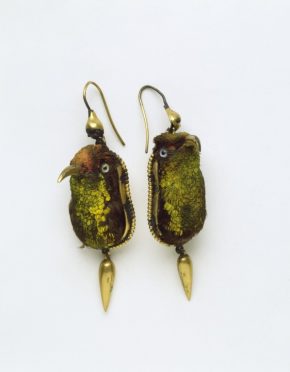Annotations - Martha Jane Anderson, "The Bird Craze" (1895)
sunny-hued songsters
Note that the color of the birds brings them into harmony with the Earth and, especially, the sun which has been a focus throughout this stanza, where the description of the changing of the season towards Summer, is dramatized in the image of Sol, the Roman god of the sun, turning southward. The "sunny-hued" birds presumably possess yellow and gold plumage.
In 2018 the Victoria and Albert Museum hosted an exhibition, "Fashioned from Nature," which included "a pair of late 19th-century earrings, made from the heads of two Red Legged Honeycreeper birds (Museum no. AP.258-1875)." In the V&A blog (17 April 2018), Katy Canales describes:  "The earrings comprise of four key parts, the first part is a gilt copper alloy hook intended to go through the earlobe. The hook is attached to a decorative, cast metal, figure of an insect, which ingeniously connects the hook to the bird’s head. The bird’s head is attached to the fourth part, a fringe of copper dangling beads that fall like a necklace from the bird’s throat. The playful juxtaposition of the metal insect by the bird’s beck, suggests it is the bird’s prey. The birds’ heads feature an enchanting array of aquamarine, cobalt, and turquoise blue plumage. The natural beauty of which is in stark contrast to the manmade fixtures that engineered the heads into earrings."
"The earrings comprise of four key parts, the first part is a gilt copper alloy hook intended to go through the earlobe. The hook is attached to a decorative, cast metal, figure of an insect, which ingeniously connects the hook to the bird’s head. The bird’s head is attached to the fourth part, a fringe of copper dangling beads that fall like a necklace from the bird’s throat. The playful juxtaposition of the metal insect by the bird’s beck, suggests it is the bird’s prey. The birds’ heads feature an enchanting array of aquamarine, cobalt, and turquoise blue plumage. The natural beauty of which is in stark contrast to the manmade fixtures that engineered the heads into earrings."
AP.259-1875 Earrings; bronze-breasted Hummingbird feathers
The vibrancy of the colors of the birds and their feathers was crucially important for their use as fashion decoration. So it is not surprising that Anna Kingsford chooses a goldfinch to represent the brutality of removing body parts from living birds in order to preserve the brightness of the plumage. In her discussion of the cruelty of the fur trade, in The Perfect Way in Diet (1881), she segues from an explicit account of the violence of seal-hunting for skins and furs, to the indiscriminate hunting of birds by young men for fun. "And yet there is one little bond of union between the fellow lurking behind the hedge-row, and the dainty lady who has just stepped out of some handsome carriage. The man has just wrung the neck of a wounded thrush, and stuffed it into his pocket to join the last shot blackbird; and the woman has a bird’s bright wing stuck on one side of her pretty hat; and on the other side a tiny humming bird, all gold, and bronze, and green, and scarlet, nods at each movement of its wearer. Yes, and we are authoritatively told that these adornments of our women are torn from the birds while yet alive, that the plumage may have its full brilliancy.
‘ Now women ought to know that they have literally no excuse for indulging in these barbarities. They have worn almost every object that can possibly be fastened to human dress. As a rule, whatever women wear seems to become them, and they have no excuse for seeking out strange devices, least of all for encouraging bird slaughter, out of the mere idleness of vanity, and for the sake of fashion. There is not one man on the face of this earth, who is not a knave or a fool, who will admire any woman the more because she has some slaughtered bird’s plumage in her bonnet. We know that those things are mere ornament. They do not protect, they do not comfort ; their sole office is to adorn, and they are literally to be ranked amongst the most brutal adornments that the depravity of bad taste has ever hung about human creatures. No woman who wears these things can know the beauty of living birds; can ever have watched them in the long spring days, or have listened to them as daylight lingers, and the air is heavy with fragrance, and glad with music. The dainty goldfinch, clad in a livery which seems as if it had been designed to unite grace with gaiety, and to show how great glory can dwell with the smallest of this earth, but a few thistle seeds to live on. His ways are charming, his colours are delightful, his music is heavenly, and he is fast disappearing that women's hats may be stuck over with wings torn from his living body. So we might go through the catalogue, for no bird is sacred from the harpies who in the secret dens of fashion dress out their dolls and paint their idols, -- idols as of old that crave for life, and are as of old to be satisfied only with living sacrifices" (112-113). The same point concerning the mutilation of living birds is made by Walter S. Weller in his article "A Cruel Fashion," published in Food, Home and Garden (March 1899): "Have any of you ever thought of the cruelty involved in the wearing of plumes or tips on your hats? It is said that the wings are actually torn from their bodies while they are still alive, in order that the brightness of the plumage may be preserved!" (43).
